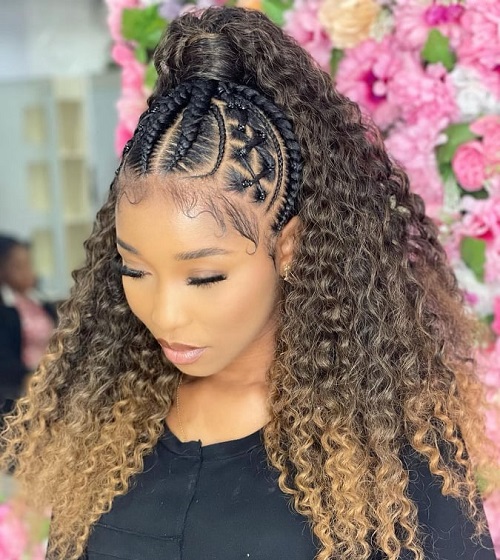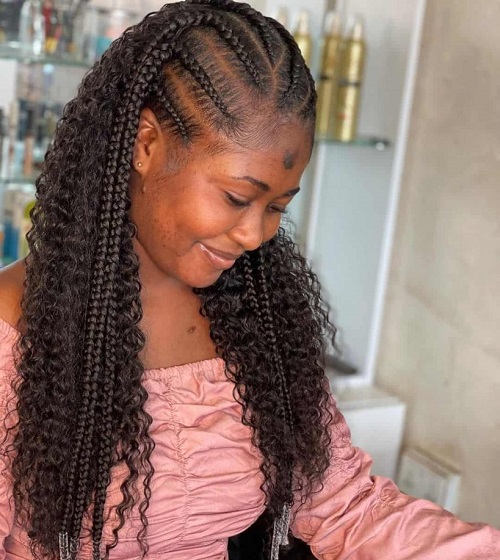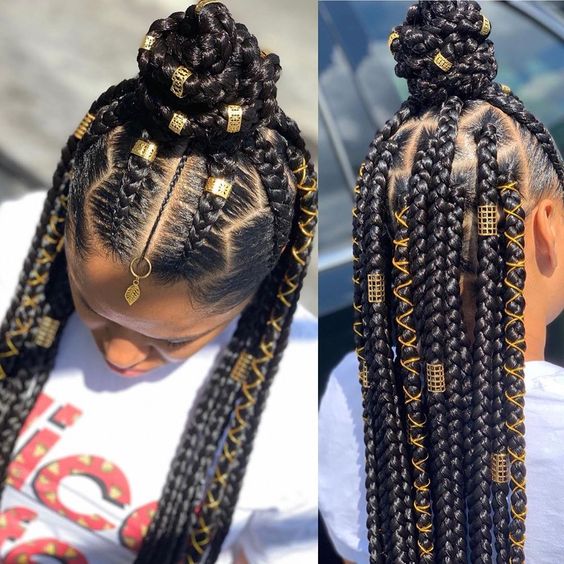Unlocking the Beauty of Tribal Braids: A Comprehensive Guide
Tribal braids, also known as Fulani braids or lemonade braids, have surged in popularity as a captivating hairstyle. With their intricate patterns and cultural significance, tribal braids have become a favorite choice for those seeking a unique and striking look. Originating from various African tribes, these braids were not only a form of stylish adornment but also served practical purposes, offering protection for natural hair growth. Today, tribal braids have surpassed cultural boundaries and become a fashion statement, celebrated for their artistry and individuality. In this article, we will explore the origins, technique, and styling options of tribal braids, providing you with the essential information to embark on a journey through the mesmerizing tribal braids hairstyle.

What are tribal braids?
Tribal braids are a unique hairstyle characterized by intricately patterned braids that are tightly woven to the scalp. Originating from various African tribes, tribal braids hold significant cultural value. They were traditionally worn to symbolize cultural heritage, social status, and personal expression.
There are various tribal braids styles, the most popular being the Fulani braids and Lemonade braids. Fulani braids, inspired by the Fulani people of West Africa, feature a central cornrow with thinner braids adorned with decoratives. Lemonade braids, popularized by Beyoncé, are thin, neat braids styled into intricate patterns. Regardless of the name, tribal braids represent diverse traditions and serve as a reminder of their rich history.
In the following sections, we will explore how to create tribal braids, and suitable hair types, and showcase stunning styles to inspire your own tribal braided look.

Pros and Cons of Tribal Braids
Tribal braids have gained popularity for their unique aesthetic, but it's important to consider both the advantages and potential drawbacks before choosing this hairstyle. Let's explore the pros and cons of tribal braids:
Advantages of Tribal Braids:
- Protective Styling: Tribal braids offer excellent protection for your natural hair. By keeping your hair neatly braided and close to the scalp, they minimize damage and promote hair growth.
- Low Maintenance: Once installed, tribal braids are relatively low maintenance. They eliminate the need for daily styling, allowing you to save time and effort on your hair routine.
- Versatility: Tribal braids offer endless styling possibilities. You can experiment with different patterns, sizes, and accessories, expressing your creativity and your style.
- Longevity: Tribal braids can last for several weeks or even months with proper care. This long-lasting nature means you can enjoy the style without frequent redoing or restyling.
Potential Drawbacks of Tribal Braids:
- Scalp Tension: The tightness of tribal braids can sometimes cause discomfort and tension on the scalp. It's important to ensure that the braids are not too tight to avoid scalp irritation and potential damage to the hair follicles.
- Extended Styling Time: Creating tribal braids can be a time-consuming process, especially if you opt for intricate designs or smaller braids. It may require several hours or multiple sessions to achieve the desired look.
- Scalp Sensitivity: Some may experience scalp sensitivity or irritation due to the braiding process or the synthetic hair extensions used. Proper care and regular scalp moisturization can help alleviate these issues.
Considering the pros and cons of tribal braids will help you make an informed decision about whether this hairstyle is suitable for you. Be mindful of your scalp's sensitivity, the time you can allocate for styling, and your preferences for low-maintenance or protective hairstyles. With proper care and attention, tribal braids can be a stunning and manageable hairstyle choice.

How to create tribal braids?
Step 1: Preparing Your Hair
Before diving into the process of creating tribal braids, it's essential to properly prepare your hair. Follow these steps to ensure the best foundation for your braided style:
- Wash your hair with a moisturizing shampoo to remove any product buildup, dirt, or oils.
- Condition your hair with a deep conditioning treatment to nourish and moisturize it.
- Detangle your hair using a wide-toothed comb or detangling brush, starting from the ends and working your way up.
- Apply a leave-in conditioner or hair oil to keep your hair hydrated and manageable.
- Allow your hair to fully dry before beginning the braiding process.
Step 2: Sectioning and Braiding
Once your hair is properly prepared, it's time to section and braid your hair to create tribal braids. Here's a step-by-step process:
- Divide your hair into neat and equal sections using a rattail comb. The size of the sections will depend on your desired braid thickness.
- Secure the sections you're not working on with hair clips or hair ties to keep them out of the way.
- Take a small subsection from one of the sections and divide it into three equal strands to begin the braid.
- Start braiding by crossing the right strand over the middle strand, then the left strand over the middle strand.
- Continue braiding, adding hair from the section you're working on to each strand as you cross them over the middle.
- Braid all the way down to the ends, securing it with a hair elastic or temporarily with a clip if needed.
- Repeat the braiding process with each section until your entire head is braided.
Step 3: Achieving Different Styles and Patterns
Tribal braids offer a wide range of styles and patterns to choose from. Here are a few ideas to help you achieve different looks:
- Experiment with various parting techniques, such as side part, straight parts, zigzags, or geometric shapes, to create unique patterns on your scalp.
- Incorporate accessories like beads, cowrie shells, or colorful threads into your braids for added flair and personalization.
- Play with different braid sizes and arrangements, such as thin or thick braids, side braids, or braids that converge into a central point.
- Explore various braid designs, such as cornrows, feed-in braids, or twist braids, to create intricate and eye-catching patterns.
Remember to be imaginative and express your style when creating tribal braids. Don't be afraid to experiment with different techniques and adapt the styles to suit your preferences. With practice and patience, you'll master the art of tribal braiding and achieve stunning results.

10 Gorgeous tribal braids styles for your inspiration
Tribal braids offer endless possibilities for chic and stunning hairstyles. Here are 10 gorgeous tribal braids hairstyles to inspire your next look, along with additional styling options:
1. Fulani Tribal Braids:
Inspired by the Fulani people of West Africa, Fulani tribal braids feature a center part with beautifully intricate braids that go to the back. You can adorn these braids with beads, cowrie shells, or other accessories to add cultural flair and personalization to your style.

2. Lemonade Tribal Braids:
Popularized by Beyoncé in her "Lemonade" album, lemonade braids are small, neat cornrows that can be styled in various patterns and sizes. These braids are sleek, stylish, and exude confidence.

3. Tribal Braids with Beads:
Elevate your tribal braids by incorporating beads along the length of the braids. The beads add an elegant touch and playfulness to your style, allowing you to express your unique personality through different bead colors and arrangements.

4. Tribal Braids with Heart Patterns:
Make a romantic statement with tribal braids styled into heart patterns. These intricate and eye-catching designs can be placed at the back or sides of your head, symbolizing love and passion.

5. Tribal Braids with Curls:
Combine the chic of braids with the softness of curls by leaving the ends of your braids loose and curling them. This style creates a harmonious blend of textures, adding movement and dimension to your braided look.

6. Goddess Tribal Braids:
Embrace your inner goddess with thick, chunky braids that make a bold and regal statement. Enhance the goddess-like aesthetic by incorporating accessories like hair cuffs or rings into your braids.

7. Multi-Layer Tribal Braids:
Add depth and texture to your tribal braids by layering them. This technique involves braiding some sections on top of others, creating a visually captivating and dynamic hairstyle.

8. Medium-Sized Tribal Braids:
If you're seeking a versatile and balanced look, medium-sized tribal braids are a great option. These braids provide intricacy without sacrificing speed, allowing you to achieve a stylish look while ensuring comfort.

9. Large Tribal Braids:
For a dramatic and voluminous style, opt for large-sized tribal braids. These braids make a bold statement, commanding attention, and exuding confidence. They're perfect for those who want to make a fierce impact.

10. Bohemian Tribal Braids:
Embrace a carefree and boho-chic vibe with bohemian tribal braids. This style incorporates loose, wispy braids, creating an effortless and relaxed appearance that's perfect for casual occasions or festival looks.

In addition to these specific tribal braids hairstyles, you can explore various styling options like updos, half-up hairstyles, and accessorizing with hair cuffs, beads, ribbons, or scarves.
Let your creativity shine through as you experiment with different patterns, sizes, and textures to create a tribal braided look that reflects your style.
Tribal Braids Maintenance and Care
Once you have created your stunning tribal braids, it's important to properly maintain and care for them to ensure their longevity and the health of your hair. Follow these tips and tricks to keep your braid s looking fresh and vibrant:
Tip 1: Cleanse your scalp: While wearing tribal braids, it's crucial to keep your scalp clean and free from buildup. Dilute a gentle shampoo with water and apply it directly to your scalp, massaging gently with your fingertips. Rinse thoroughly and follow up with a conditioner applied to the lengths of your braids.
Tip 2: Moisturize your braids: Keep your braids hydrated by applying a lightweight moisturizing spray or hair oil to your scalp and braids regularly. This helps prevent dryness, itchiness, and breakage. Be sure to focus on the ends of your braids, as they tend to be more susceptible to dryness.
Tip 3: Protect your braids at night: Before bed, wrap your braids with a satin or silk scarf or sleep on a satin pillowcase. This helps minimize friction, reduces frizz, and preserves the neatness of your braids. Avoid using cotton pillowcases, as they can cause friction and lead to hair breakage.
Tip 4: Be mindful during physical activities: If you engage in physical activities or exercise, protect your braids by wearing a headband or tying them up in a bun or ponytail. This prevents excessive tugging or pulling on the braids, reducing the risk of damage.
Tip 5: Avoid excessive tension: Ensure that your braids are not too tight, as this can cause discomfort and put excessive tension on your scalp. If you feel any pain or discomfort, consider loosening the braids slightly to relieve the pressure.
Tip 6: Minimize product usage: While it's important to keep your scalp moisturized, avoid using heavy or greasy products that can weigh down your braids or cause product buildup. Opt for lightweight oils or moisturizers specifically formulated for braided hairstyles.
Tip 7: Handle with care: Be gentle when styling or manipulating your braids. Avoid pulling or tugging on them excessively, as this can lead to breakage or damage. Use a wide-toothed comb or your fingers to detangle your braids, starting from the ends and working your way up.
By following these maintenance and care tips, you can ensure that your tribal braids remain in good condition and preserve the health of your natural hair. With proper care, your braids can last for several weeks, allowing you to enjoy the beauty and versatility of this captivating hairstyle.
Click and discover various tribal braid hairstyles!
Explore and find your perfect tribal braided wig at our partner site: mybraidedwig.com!

Tribal Braids FAQs:
Q: How long can tribal braids last?
A: Tribal braids can last anywhere from two to eight weeks, depending on various factors such as your hair type, the tightness of the braids, and how well you care for them. It's important to monitor your braids for signs of fraying or damage and remove them if necessary to avoid any potential harm to your hair.
Q: How long does it take to create tribal braids?
A: The time required to create tribal braids can vary depending on factors such as the length and thickness of your hair, the intricacy of the braiding style, and the skill level of the braider. On average, it can take several hours to several sessions spanning a few days to complete a full head of tribal braids.
Q: What is the cost of getting tribal braids?
A: The cost of getting tribal braids can vary depending on factors such as your location, the expertise of the stylist, and the length and thickness of your hair. It's best to consult with a few local hair salons or braiders to get an estimate of the pricing in your area.
Q: Can you wash tribal braids?
A: Yes, you can wash tribal braids. However, it's important to be gentle and mindful of the braids while washing to prevent them from unraveling or becoming frizzy. Use a diluted shampoo or a cleansing spray specifically formulated for braids, focusing on the scalp and avoiding excessive manipulation of the braids themselves. Follow up with a lightweight conditioner or leave-in spray to keep your hair moisturized.
Q: Can you put tribal braids into a ponytail?
A: Yes, you can put tribal braids into a ponytail. However, be cautious not to create excessive tension on the hairline or the roots of the braids, as this can cause discomfort or damage. Opt for loose, low ponytails or other gentle updo styles that distribute the weight evenly and avoid pulling on the braids.
Q: How to prevent frizz and maintain a neat appearance?
A: To prevent frizz and maintain a neat appearance, avoid excessive touching, rubbing, or playing with your braids, as this can cause friction and lead to frizz. Use a lightweight hair oil or anti-frizz serum to smooth down any flyaways or frizzy sections. Additionally, sleeping on a satin pillowcase or using a satin scarf or bonnet at night can help reduce friction and keep your braids looking neat.
Q: Tips for moisturizing the scalp and relieving itching?
A: To moisturize your scalp and relieve itching while wearing tribal braids, use a lightweight moisturizing spray or oil specifically designed for braids. Apply the product directly to your scalp and massage it gently using your fingertips. Avoid using heavy oils or greases, as they can cause buildup and weigh down your braids. If you experience excessive itching, you can also try using a soothing scalp spray or applying a small amount of aloe vera gel to calm irritation.
By following these maintenance tips, you can extend the lifespan of your tribal braids, keep them looking fresh, and ensure the health and comfort of your hair and scalp.
Conclusion:
In conclusion, tribal braids offer a beautiful and culturally significant hairstyle option that celebrates diversity and individuality. Whether you choose to wear tribal braids without extensions or prefer adding length and volume with high-quality human hair extensions, such as those available at Ula Hair, the choice is yours. Embrace the beauty and versatility of tribal braids and let them be a reflection of your style and appreciation for diverse cultures. So go ahead, try out tribal braids, and let your personal style shine through.
Related Posts:
All You Need To Know About Peekaboo Braids
A Comprehensive Guide To Pop Smoke Braids
20 Chic Braids For Black Women In 2023
Half Up Half Down Braids Hairstyles For Black Hair

 USD
USD EUR
EUR GBP
GBP CAD
CAD












